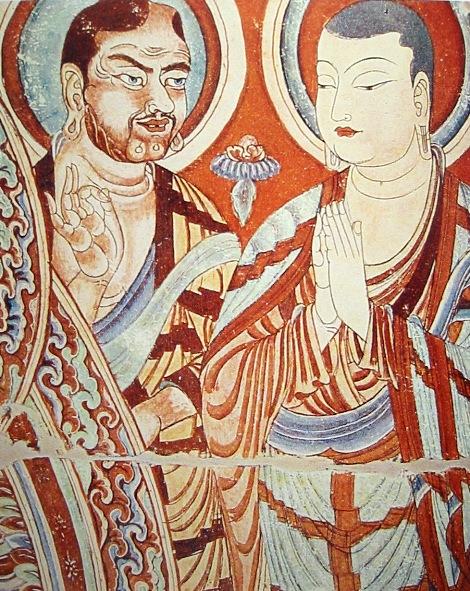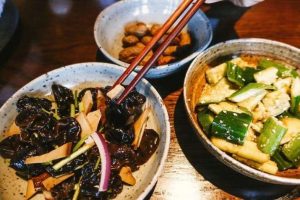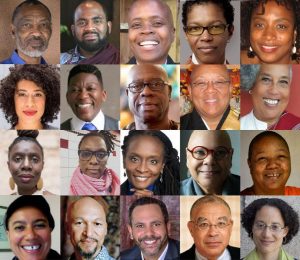
Editor’s note: This article was first published in the now-retired Bodhi Journal, Issue 8, June 2008.
When examining the influence of Mahayana Buddhism in Sri Lanka it would be appropriate to approach the topic from a human interest angle before moving into history, archaeology and the academic sphere. A glance at the role of Mahayana in contemporary Sri Lankan society, I believe, will be a guide to the impact of this school of Buddhism here.
A common practice among Sri Lanka’s Theravada Buddhist families is to give alms to the Sangha on the seventh day after the death of a near and dear one.
The Venerable Balangoda Dhammananda, Chief Incumbent of the Piyarathanarama Temple, Nedimala-Dehiwala, a suburb of Colombo, traces this practice of giving alms (a week after death) to the belief in gandhabba – a state of mind that exists between the death and rebirth of a being. When a person passes away it is hoped to transfer to him/her merit gained by giving alms to the Sangha on the seventh day after death. It is widely accepted that the idea of gandhabba spread in Sri Lanka via Mahayana sects that emerged during the Anuradhapura period of Sri Lanka’s history.
In Theravada there is no gandhabba. Instead rebirth (or re-becoming) occurs at the instant death strikes. Depending on his/her karma the person may be reborn a human, an animal or a spirit (a formless being). So an almsgiving to the Sangha in his/her memory after seven days serves no purpose, if the departed is reborn into a state where merit could not be transferred (like being born a human or animal), according to Theravada. It becomes meaningful only if the deceased is reborn in the spirit world.
Nevertheless the practice of the seventh day alms giving is now in the “blood of our Buddhists,” says the Venerable Dhammananda.
A most notable feature of Mahayana influence here was the Bodhisatva concept. King Sirisangabo (A.D. 251-253) was such a strong believer in it that he gave up his throne rather than give orders to kill people when a relative, Prince Gotabhaya led a rebellion to seize power. After the practice of worshipping Bodisatvas began in Sri Lanka, many a Bodhisatva statue came up in different parts of the island. The most well-known of these is Kushtaraja in Weligama. According to Historian, G.C. Mendis, the deity Natha worshipped by Sri Lankan Buddhists is Bodhisatva Avalokiteshwara or Lokeshwara Natha (Ceylon History 1961). A number of local Buddhist temples have within their premises shrines built for this deity.
Mahayana influence began to take hold on Sri Lanka around the seventh Century and reached its zenith during the rule of King Mahasen (A.D. 276-303). By the 7th and 8th Centuries the centres of Mahayana practices were the Abhayagiri and Jethawana monasteries (which also includes the country’s largest stupa) complexes in Anuradhapura, Sri Lanka’s ancient capital.
When the Chinese itinerant monk the Ven. Fa-hsien (A.D. 412-414) arrived in Sri Lanka, Abhayagiri was enjoying a very prosperous period. Sanskrit works such as Deerghagama, Sanyuktagama, Samyukta Sanchayapitaka and the Vinaya Pitaka based on the Mahinsasaka tradition, which he took to China, are believed to have been obtained from Abhayagiri.
Mahayana beliefs, especially the Saddharmapundarika sutra was known in ancient Sri Lanka as Vitulyawada, according to the Venerable Aththudawe Rahula, Ven. Bambarende Pannaloka and Bambarende Mahanama (Buddhist Civilization 1980).
Sanskrit studies received a major boost as a result of the spread of Mahayana in the island. Stone inscriptions on Buddhist beliefs and practices written in Sanskrit have been found in Anuradhapura. An eighth century stone inscription clearly proves that the occupants of Abhayagiri monastery knew Sanskrit well (Ceylon History by G.C. Mendis).
Dr. Nandasena Mudiyanse was the first to do a detailed study of Mahayana in Sri Lanka (Mahayana Monuments in Sri Lanka, Colombo 1967), according to Dr. Hema Goonatilake who covered Mahayana influence in Sri Lanka (The Impact of Mahayana on Sinhalese Buddhism), for her unpublished PhD thesis (London 1974).
There, Dr. Goonatilake notes that Sri Lanka was a centre of non-orthodox teachings from an early period. Fa-hsien had recorded that 5,000 monks were in the Abhayagiri while 3,000 in Mahavihara, the centre of Theravada (Hinayana) Buddhism.
The Abhayagiri stupa was 470 ft in height. The Tooth Relic festival was held at Abhayagiri once year when the relic was brought there once a year for public exhibition. The Vetulla (Vaitulya) school was the most well known Mahayana Sect at the time. King Silakala (518-531) was a samanera at Bodh Gaya monastery during the time Mahayana was gaining ground in India and was a follower of Mahayana. He believed in Dhammadhatu, a treatise on Trikaya (practice of enshrining scriptures of the Trikaya concept) as the true doctrine and supported the Jetavana Vihara.
Chinese sources have revealed that Mahayanism was strongly entrenched in Sri Lanka. Inscriptions depicting aspiration for Buddhahood-invocations to Bodhisattvas (e.g. Tiriyaya inscription of the 7th Century) confirm this. Trikaya doctrine was popular in 8th Century (e.g. Trikayastava inscription of Mahintale). Pragnaparamita sutra was found at Indikatuseya, Mihintale. By the 9th and 10th Centuries, Abhayagiri Vihara complex covered an area of 300 acres. (R.A.L.H Gunawardana).
Among the ruins seen at the Abhayagiri monastery complex is the Mahayana Stupa – situated to the West of Elephant pond (Eth Pokuna). A lead scroll found there with Mahayana mantras written on it caused the structure to be called Mahayana Stupa (Abhayagiri Vihara at Anuradhapura by Professor T.G. Kulatunga – Central Cultural Fund)
By 8th Century, Sri Lanka was a centre of Tantrism or Thanthrayana. The most Influential of the three patriarchs who propagated this sect in China was Amoghavajra. He translated a large number of texts into Chinese and was popular with the Imperial Family and also performed the abhiseka (coronation) of the Emperor. Amoghavajra was born in ‘Simhala’ (Land of the Lions) as Sri Lanka was known in China then. In AD 705 he became a pupil of Vajrabodhi in Yavadvipa (in Java or in South India) and went with him to China. Later he arrived in Sri Lankawith a message from the Chinese Emperor & and accorded royal reception by the then King of Sri Lanka, Ilamegha (Aggabodhi VI A.D.733-772). He was highly venerated by the royal family – the king bathed Amoghavajra every day with scented water (Pachow, Ancient Cultural Relations Between Ceylon & China, UHC, Vol XI. No. 3 & 4, Encyclopaedia of Buddhism).
Acharya Samantabhadra was a well known Tantrist in Sri Lanka at the time. Amoghavajra with his two Chinese disciples received further training from him for two years in Tantric practices such as two mandalas (Garbhadhatu & Vajradhatu), abhisecani, dharani, mudra etc. Amoghavajra collected 100,000 slokas of Vajrasekharayogasutras, 500,000 slokas of mantras, sutras, satras of various schools Yuan-chao’s Sung-kao-seng-chuan), more than 500 sutras and commentaries (Taisho Tripitaka). After returning to China, at Emperor’s request, he translated Sanskrit works into Chinese and intiated thousands of pupils for 40 years.
Amoghavajra’s Malayan teacher Vajrabodhi who studied in Nalanda University too visited Sri Lanka, stayed for half a year in Abhayagiri, went in pilgrimage to Sripada, visited Ruhuna and converted the king (Silamegha) to Mahayana.
An 8th Century inscription recording the establishment of an “Abhayagiri Vihara of Sinhalese ascetics” was found in Ratubaka plateau in central Java. Casparis Identified Buddhism at Ratbaka as Mahayana. (‘New evidence on cultural relations between Java and Ceylon’, Artibus Asiae, 24, 1961, pp. 241-248)
An ascetic of the Vajraparvata nikaya in India, also known as Vajiriyavada came to Sri Lanka in the 9th century and resided at Abhayagiri, according to the Nikayasangrahaya.
Most of the Tantra texts attributed to this sect have been in Tibetan and Chinese translations, e.g. Mayajalatantra, Samajatantra, Tattvasangrahatantra, Vajramrutatantra, Cakrasamvaratantra, Dvadasacakratantra, Mahamayatantra, Catuspitahatantra, Sarvabuddhatantra, Samuccayatantra etc. It has been established that Vajiriyavada that was introduced to Sri Lanka was Vajrayana.
By the 10th Century, pillars of a temple within the precincts of the Thuparama Were identified as tridents (vajra), similar to the dorja or thunderbolt of Tibet which is usually held by Mahayana Bodhisattvas (A.M. Hocart, ‘Archaeological Summary).
By the 12th Century, Tantrism became a living force when Parakramabahu I built a dharanighara for the recitation of magic incantations – where Tantrists recited dharanis.
Nalanda Gedige (8h Century) was an image house where Tantric rituals were performed. Tantrimalai (Tantra Hill) (PE.E. Fernando).
The Ven. Rangama Chandawimala of the University of Hong Kong studied for his Ph.D thesis primary literary sources on Tantric practices that were available in Sri Lanka.
Sri Lanka’s former Archaeology Commissioner Dr. Raja De Silva in his scholarly assessment of Sri Lanka’s World Heritage site Sigiriya states that King Kassapa I (478-496) who figures prominently in the history of the famous rock was a follower of Abhayagiri monks. Dr. De Silva believes that available evidence reveals a strong possibility that the site was a Mahayana monastery. According to him that the well-known Sigiriya frescoes which were iconised depict Tara – the consort of the Bodhisatva Avalokiteshwara (Sigiriya and its Significance /Digging into the Past)
There were however periodic conflicts between the bhikkus of Abhayagri and Jethawana on the one side and those of Maha Vihara on the other. The latter Considered themselves the guardians of Orthodox Pali Buddhism (Theravada or Hinyana) At times books were burnt causing great losses.
Many rituals among Sri Lankan Buddhists are rooted in Mahayana. Works such as Nikayasangrahaya, Buthsarana, Daham Sarana and Sanga Sarana have been attributed to its impact on Sri Lankan society. Mahayana also popularised the chanting of sutras (pirith or parithha) and all forms of Buddhist rituals as well as contributed greatly to the development of art forms.
Fourteen years ago a young Sri Lankan researcher H.M. Moratuwegama began observing similarities in the Zen art of story-telling and the art of story telling in certain Theravada scriptures and commentaries. These he included in a book in Sinhala titled Buddhankura (Seeding of Buddhahood).
Some of the gardens of Zen temples such as Japan’s Ryoangi Temple bear a striking similarity to the well-swept sandy floors of Sri Lankan temple gardens.
In conclusion let us recall the words of the late Venerable Professor Walpola Rahula at a seminar organized by the Institute of Pali and Buddhist Studies in 1994. There he told the participants that the differences between Mahayana and Theravada have been over emphasized by Western writers.






